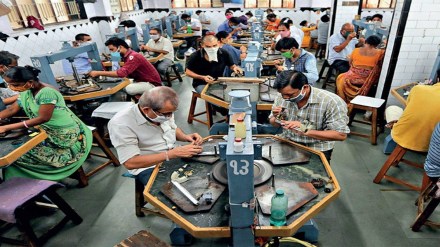Here at Katargam, one of the nerve centres of Surat’s famed diamond cutting and polishing hub, tall gated buildings abut one another. Each of them houses manufacturing units of varying shapes and sizes. While some operate with anonymity, others have the company names emblazoned on the facade.
There are an estimated 5,000 such units spread across the Surat agglomeration, among themselves employing over 800,000 people. About 90% of the world’s cut and polished diamonds are manufactured here.
In one of the units sits Ajay Kumar, a migrant worker from Bihar, who has been working in the industry for over six years now. Hunched over a table, eyes fixed on a machine, Kumar and his three co-workers share a tiny space as they go about their ten-and-a-half-hour shift. The floor holds about 40-50 such tables, each shared by four men, who are in turn supervised by their managers sitting across the floor in glass cabins.
“Yes, I am getting work. We are all getting work,” Kumar said, when asked whether the US tariffs have had any impact on his work schedules in recent days.
Others, who are from Uttar Pradesh and Maharashtra, nod in agreement. These workers have been getting steady shifts with monthly pay ranging from Rs 15,000-20,000. Most of them have been working in the same unit for several years. And is it possible for anyone to get a fresh job in these units? Of course, says Kumar, as others echo his claim.
Factory Floors Still Busy
A little away in Mota Varachha district is Gopal, ensconced himself on a similar factory floor. He is a native of Una district in Gujarat’s Saurashtra region. He is one of the few workers who has an idea of US president Donald Trump’s 50% tariff threat to India. “It’s not 50% yet, right?” he asks. “It’s 20-25% I think, but we are still getting work.”
The factory floors where work is in full swing presents, however, a stark contrast to the situation in the boardrooms and offices of diamond company CEOs and directors. Their evaluation of the tariff wars is different, although their assessment of the situation and the future holds for the industry vary much.
Ashesh Doshi of AN Diamonds says that units here have already dispatched Rs 9,230 crore worthf cut and polished diamonds in July, to preempt the 25% tariff that took effect on August 2. Most manufacturers keep a month’s stocks of rough diamonds, which keeps the jobs of labourers and artisans safe for the time being.
“Yes, many companies are operating at loss, and the situation is indeed precarious. But we have goods that can sustain employment for a month and a half, maybe until Diwali too. If you account for the holidays and any additional leaves companies may give to their employees, there are probably 50-55 working days before Diwali,” Doshi said.
If the tariffs aren’t reduced, he warns, companies will have no choice but to eventually let go of the staff.
Tariffs Cast a Long Shadow
While many of Surat’s diamond units continue operating at almost full capacity, cities such as Amreli, Bhavnagar and Junagadh, which have relatively smaller units, have reported cutting almost 100,000 jobs since April.
Bapubhai, who manages a group of workers at Yogi Gems in Surat, has been in the business for over 20 years. He explains how companies try not to let their employees go as it becomes incredibly difficult to find skilled artisans and labourers when the industry bounces back. “The number of young workers in the industry is on a rapid decline, as they prefer other businesses or stable industries like textiles,” he says.
“To adjust costs, some units have started giving workers half-day off or more holidays, and some have even cut wages. For now, we haven’t been given any holidays. It’s business as usual.”
What about US tariffs? “We will see what happens. For now, we are getting work,” he shrugs it off.
With India exporting nearly 30% of its polished diamonds to the US, new orders are already drying up. Nagji Sakariya of HVK International, however, remains confident that while the industry is going through unprecedented times, the tides may turn.
“There are about 75,000 to 80,000 jewellery stores in the US, all of which will be affected by the tariff as well,” he reasons. “And even if manufacturers in India run out of stocks, many companies have taken to lab-grown diamond (LGD) production, which can temporarily sustain employment.”
Industry experts estimate that over the past few years, worker wages have been slashed by 30-40%. As companies acknowledge that operating on a 25% tariff itself is not feasible, their artisans and employees risk grappling with further pay cuts. Kumar, who lives with his wife and child, said, “Today, even basic groceries and vegetables are expensive. While our monthly wages cover some expenses, we cannot afford further deductions.”
A pall of gloom has apparent;y descended over them, while discussing a possible further drop in wages. Many of them say that it would be “difficult” for them and their families. However, as of now, the employers know the situation better and are themselves keeping their fingers crossed.
Most companies know that replacing the US market is incredibly difficult, if not impossible. But even as they are busy exploring newer markets, the livelihoods of Surat’s diamond workers hang in the balance.
